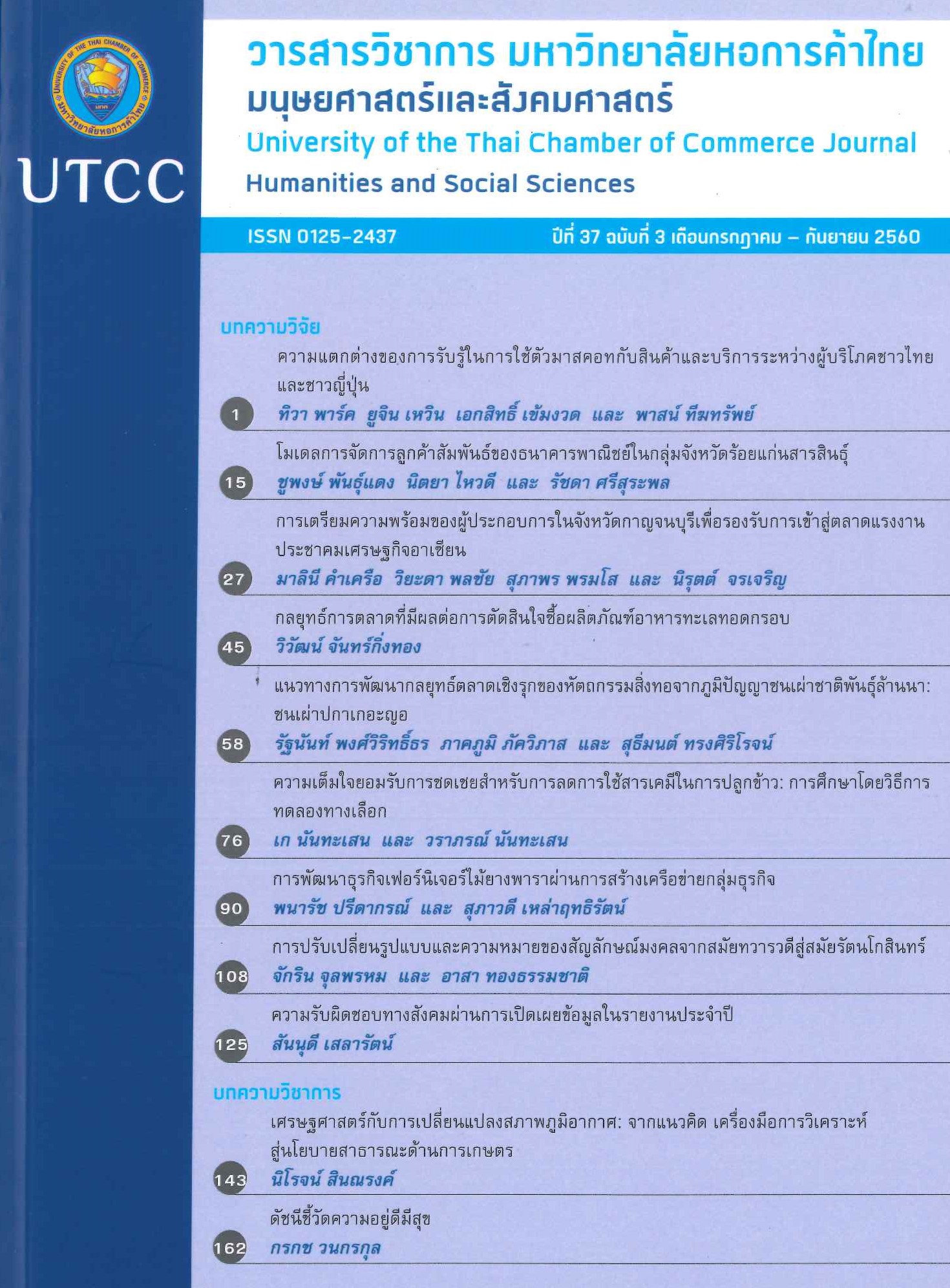Perception Differences in Using Brand Mascots on Products and Services between Thai and Japanese Consumers
Main Article Content
Abstract
International companies use brand mascots as a part of their marketing strategies to attract customers and build brand loyalty, therefore understanding the effectiveness of marketing these mascots as well as theirs effects on consumers depending on individual differences would be important knowledge. This research aims to investigate if there are personal and demographic differences in perceiving mascots, specifically gender, age, nationality (Thai and Japanese), and
other relevant factors. The researchers hypothesized that females are more likely to remember mascots and product/services than males, participants below 18 years old are more likely to remember mascots than older participants, and Japanese participants are more likely to remember product/services than Thais but Thai participants will be more likely to buy product/service after knowing mascots compared to Japanese participants. The results show a lack of age differences, some minor gender differences with similarities between Thai and Japanese females towards mascots, and strong national differences in perceiving mascots, while another strong factor for
remembering mascots is passion for cartoons. In addition, factors that have encouraged both Thai and Japanese to remember brand mascots for buying items are the cuteness of mascots, seeing the advertisement often on media channels as well as the attractiveness of brand mascot which was colorful than others. The findings also indicate that there is a significance relating to the effect of advertising media of brand mascots on consumer perception.
Article Details
ลิขสิทธิ์ของบทความ
ผลงานที่ได้รับการตีพิมพ์ถือเป็นลิขสิทธิ์ของมหาวิทยาลัยหอการค้าไทย ห้ามมิให้นำเนื้อหา ทัศนะ หรือข้อคิดเห็นใด ๆ ของผลงานไปทำซ้ำ ดัดแปลง หรือเผยแพร่ ไม่ว่าทั้งหมดหรือบางส่วนโดยไม่ได้รับอนุญาตเป็นลายลักษณ์อักษรจากมหาวิทยาลัยหอการค้าไทยก่อน
References
Abernety, A.M., & Frank, G.R. (1996). The information content of advertising a meta-analysis. Journal of Advertising Research, 2, 1-17.
Aiemraaorpakdee, P. (2009). Role of brand identity in determining the popularity of brand reputation. University of the Thai Chamber of Commerce Journal, 29(3),183-192. (in Thai).
Aiemraaorpakdee, P. (2010). Personal branding in business. University of the Thai Chamber of Commerce Journal, 30(2), 116-123. (in Thai).
Atkin, C., & Miller, M. (1975). The effects of television advertising on children: Experimental evidence. Washington, DC: Office of Child Development
Bhattacharya, C.B., & Sen, S. (2003). Consumer- company identification: A framework for understanding consumers’ relationships with companies. Journal of Marketing, 67,76-89
Blair, T.C., & Chiou, S.C. (2014). The impact of brand knowledge on consumers of different genders and from different cultures. Asia Pacific Management Review, 19(1), 47-59.
Brown, S. (2010). Where the wild brands are: Some thoughts on anthropomorphic marketing. The Marketing Review, 10(3), 209-224.
Chang, E.C. (2014). Influences of the spokes- character on brand equity antecedents. Asia Pacific Journal Market Logistics, 26, 494-515.
Connell, P.M., Brucks, M., & Nielsen, J.H. (2014). How childhood advertising exposure can create biased product evaluation that persist into adulthood. Journal Consumer Research, 41, 119-134.
Cooper-Chen, A. (1999). An animated imbalance. Gazette, 61(3-4), 293-310.
Costa, M. (2010, March 25). Brand characters: Pulling customers’ heart strings. Marketing Week, p. 16
Delbaere, M., McQuarrie, E.F., & Phillips, B.J. (2011). Personification in advertising. Journal of Advertising, 40(1), 121-130
Dotz, W., Morton, J., & Lund, J.W. (1996). What a character?: Twentieth-century American advertising icons. San Francisco, CA:Chronicle Books.
Fletcher, M. (2001). A taste of real life. Marketing Event, 35(2), 2
Fournier, S. (1998). Consumers and their brands: Developing relationship theory in consumer research. Journal of Consumer Research, 24(4), 343-373.
Freling, T.H., Crosno, J.L., & Henard, D.H. (2010). Brand personality appeal: conceptualization and empirical validation. Journal of the Academy of Marketing Science, 39(3), 392-406
Hemar-Nicolas, V., & Gollety, M. (2012). Using brand character when targeting children: What for? an exploration of managers’
and children’s viewpoints. Young Consumers: Insight and Ideas for Responsible Marketers, 13: 20-29.
Hofstede, G. (1984). Culture’s consequences: International differences in work-related values. Beverly Hills, CA: Sage.
Jacobson, L. (2008). Advertising, mass merchandising, and the creation of children’s consumer culture. In L. Jacobson (Ed.), Children and consumer culture in American society: A historical handbook and guide (pp. 3-25). Westport, CT: Greenwood.
Kraak, V.I., & Story, M. (2015, February). Influence of food companies’ brand mascots and entertainment companies’ cartoon media characters on children’s diet and health: A systematic review and research needs. Obesity Reviews, pp. 107-126
Mascots: Building place in consumers’ heart. (2013). Retrieved August 25, 2016, from https://www.campaignlive.co.uk
Neeley, S., & Schumann, D. (2004). Using animated spokes-character in advertising to young children: Does increasing attention to advertising necessarily lead to product preferences. Journal of Advertising, 33(3), 7-23.
Patterson, A., Khogeer, Y., & Hodgson, J. (2013). How to create an influential anthropomorphic mascot: Literary musings on marketing, make-believe, and meerkats. Journal of Marketing Management, 29(1-2), 69-85
Richert, R.A., Robb, M.B., & Smith, E.I. (2011). Media as social partners: The social nature of young children’s learning from screen media. Child Development, 82, 82-95
Schultz, E.J. (2012). Mascots are brand’s best social-media accessories. Advertising Age,83(13), 2-25.
Thompson, T., & Zerbinose, E. (1997). Television cartoons: Do children notice it’s a boy’s world?. Sex Roles, 37(5-6), 415-432.
Warapitayut, K. (2014). A preliminary study of the possibility of branding communication through print media and special events for generation –Y. University of the Thai Chamber of
Commerce Journal, 34(1), 164-176. (in Thai).
Woodside, A.G. (2008). Using the forced metaphor-elicitation technique (FMET) to meet animal companions within self. Journal of business Research, 61(5), 480-487.
Yukantawanithchai, T. (2010). IMC (Integrated Marketing Communication). University of the Thai Chamber of Commerce Journal, 30(2), 99-115. (in Thai).


